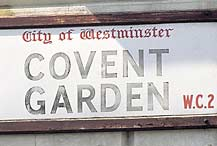|
Present situation |
||
|
Covent Garden enters our history as the abbey (or convent) of St Peter at Westminster. It dates back to medieval days when the Abbey of Westminster owned the 'Convent Garden' from which surplus produce was sold to Londoners near to The Strand. A regular market grew up. The Covent Garden area was in the 17th century the scene of the first experiment in London of town planning, and the creation of the first public square in the country. The market square was partly designed by Inigo Jones. He designed this elegant square for the rich and fashionable. By 1750 they had moved west, and Covent Garden became a noisy produce market by day and a notorious red-light district by night. |
 From both texts find answers to the following questions.
|
Covent Garden is an area of central London most noted for its flower, fruit and vegetable market (now moved to Nine Elms) and the Royal Opera House. The phrase is commonly used to describe the open area at its centre - for which 'Covent Garden Piazza' is the proper name. Covent Garden is the centre of London's theatre and entertainment district. There are lots of trendy alternative shops, markets, music, and restaurants in this area to explore. Much of the area is closed to traffic, In summer there's live entertainment including music, magic, juggling or performance art. |